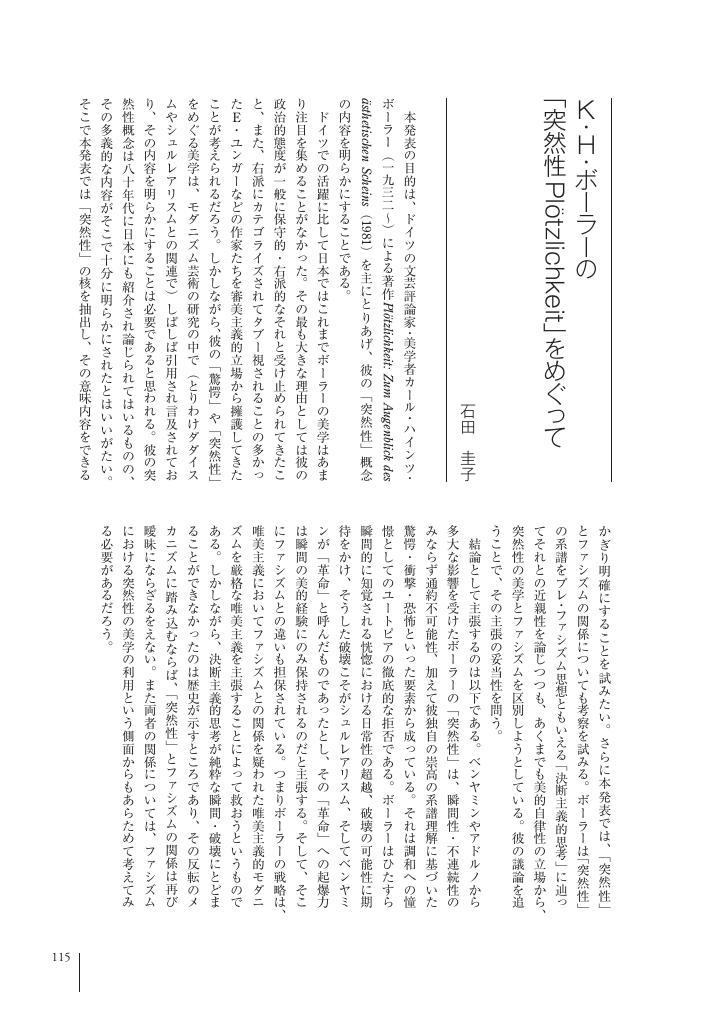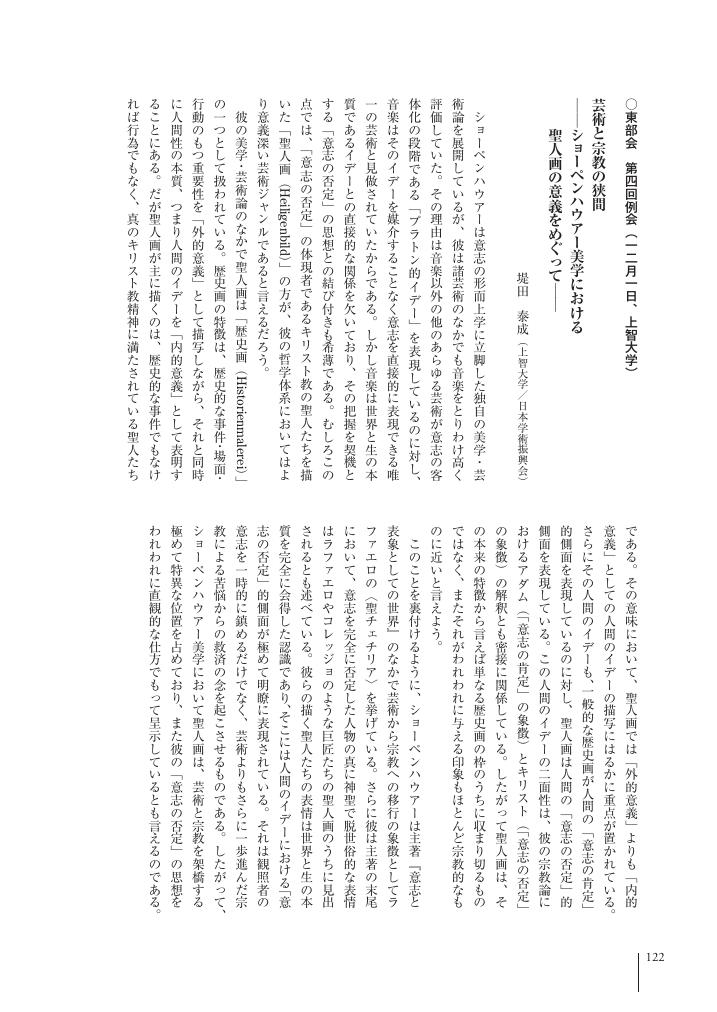1 0 0 0 OA カリフォルニア時代のマン・レイ ─クヌド・メリルの「フラックス」との比較を通して
- 著者
- 木水 千里
- 出版者
- 美学会
- 雑誌
- 美学 (ISSN:05200962)
- 巻号頁・発行日
- vol.70, no.2, pp.73-84, 2019 (Released:2021-05-08)
Man Ray, American artist, went to France in 1921 asking for a place of new activity. At the outbreak of the Second World War, he returned to his country in 1940, and spent about 10 years in Los Angeles. However, while attention has focused on the photographic works of the surrealist period of the 1920s and 1930s, his activities during his stay in California is rarely discussed. One considers Man Ray led a retired life there. In this paper, focusing on the fact that Man Ray was involved in an abstract art group called “Open Circle”, we examine about his California era. In particular, our purpose is to report on his activities in the Californian art field through his relationship with the painter Knud Merrild born in Denmark, who produced the paintings and named them “Flux” with techniques such as Dripping and Pouring. Attempts to elucidate artistic activities of Man Ray in Los Angeles allow us to move away from the post war art history which explains the center of art was transferred from France to the United States, namely New York. It will also be an opportunity to review the history of art from a local perspective.
1 0 0 0 OA ヌーヴォー・レアリスムの詩学
- 著者
- 渡辺 洋平
- 出版者
- 美学会
- 雑誌
- 美学 (ISSN:05200962)
- 巻号頁・発行日
- vol.70, no.2, pp.85-96, 2019 (Released:2021-05-08)
Under the direction of the critic Pierre Restany, Nouveau Réalisme was formed at the flat of Yves Klein in Paris, on October 27, 1960. This movement was made up of 13 artists including Klein, and many of them eventually became world-famous artists. However, despite of this interesting fact, their activities as a group have not been discussed sufficiently in the past. But now, there is no doubt that Nouveau Réalisme is being historically re-evaluated all over the world. In this article, following this trend, we attempt to reexamine the movement by considering their “poetics”. Nouveau Réalisme was supported by Restany’s theory of “appropriation of the real”. But this theory was neither accepted by all participants, nor so effective to analyze their works. So, we reconsider the theory of Restany, and try to separate works of Nouveau Réalisme from the concept of appropriation. Our aim is to clarify their thoughts presented in their works themselves, and to illuminate them as poetics of Nouveau Réalisme. Our proposition is below: their particularity should be sought in “making a new sight” or “new perceptual approach to reality”, and it is here that their poetics are found.
1 0 0 0 OA 一九六〇年代初頭の高橋悠治によるジョン・ケージの「偶然性」批判
- 著者
- 峠岡 悠希
- 出版者
- 美学会
- 雑誌
- 美学 (ISSN:05200962)
- 巻号頁・発行日
- vol.70, no.2, pp.97-108, 2019 (Released:2021-05-08)
In the early 1960s, the arrival of John Cage’s aleatoric music caused a sensation in the musical world of Japan. The reaction was known as the “John Cage Shock”. Many Japanese critics and musicians considered the essence of Cage’s music to exist in the chance operations of his method of composing music. The interpretation of this concept among many critics tended to the metaphysical and mystic. Yuji Takahashi (1938-) argued that these assessments were inaccurate and asked, “Where is chance in John Cage’s works?” He proposed to understand Cage’s work through the concept of indeterminacy. Cage himself, of course, also used this term. However, Takahashi’s idea of indeterminacy differs from Cage’s; Takahashi’s idea focuses on the indeterminacy that intervenes not only between scores and performances but also between the performed sound (Takahashi referred to it as the vague sound) and the audience. However, this understanding of indeterminacy fails to account for Cage’s usage of this type of sound in his works. Cage’s aleatoric music and indeterminacy cast a long shadow over Japanese music post the Second World War. This paper assesses the reception of Cage’s music in Japan, indicating Cage’s influence on Takahashi’s compositions.
1 0 0 0 OA 居住環境における「親しみ」の美的経験の成立条件
- 著者
- 青田 麻未
- 出版者
- 美学会
- 雑誌
- 美学 (ISSN:05200962)
- 巻号頁・発行日
- vol.70, no.2, pp.114, 2019 (Released:2021-05-08)
1 0 0 0 OA K・H・ボーラーの 「突然性 Plötzlichkeit 」をめぐって
- 著者
- 石田 圭子
- 出版者
- 美学会
- 雑誌
- 美学 (ISSN:05200962)
- 巻号頁・発行日
- vol.70, no.2, pp.115, 2019 (Released:2021-05-08)
1 0 0 0 OA 香港新浪潮における作家と脚本の関係 『蝶變』を中心に
- 著者
- 雑賀 広海
- 出版者
- 美学会
- 雑誌
- 美学 (ISSN:05200962)
- 巻号頁・発行日
- vol.70, no.1, pp.130, 2019 (Released:2021-05-08)
1 0 0 0 OA ポール・セザンヌと写真 一九世紀における絵画と写真の交流の一様相
- 著者
- 秋丸 知貴
- 出版者
- 美学会
- 雑誌
- 美学 (ISSN:05200962)
- 巻号頁・発行日
- vol.70, no.1, pp.131, 2019 (Released:2021-05-08)
- 著者
- 岡林 洋
- 出版者
- 美学会
- 雑誌
- 美学 (ISSN:05200962)
- 巻号頁・発行日
- vol.70, no.1, pp.108-111, 2019 (Released:2021-05-08)
1 0 0 0 OA 島本浣, 『日仏「美術全集」史―美術(史)啓蒙の200年』,三元社, 二〇一六年
- 著者
- 柳沢 史明
- 出版者
- 美学会
- 雑誌
- 美学 (ISSN:05200962)
- 巻号頁・発行日
- vol.70, no.1, pp.112-116, 2019 (Released:2021-05-08)
1 0 0 0 OA 芸術と宗教の狭間 ショーペンハウアー美学における 聖人画の意義をめぐって
- 著者
- 提田 泰成
- 出版者
- 美学会
- 雑誌
- 美学 (ISSN:05200962)
- 巻号頁・発行日
- vol.70, no.1, pp.122, 2019 (Released:2021-05-08)
1 0 0 0 OA 美学と癒し G・ F・マイアー(一七一八─七七)の 美学的情動論をめぐって
- 著者
- 小林 直子
- 出版者
- 美学会
- 雑誌
- 美学 (ISSN:05200962)
- 巻号頁・発行日
- vol.70, no.1, pp.123, 2019 (Released:2021-05-08)
- 著者
- 桑原 俊介
- 出版者
- 美学会
- 雑誌
- 美学 (ISSN:05200962)
- 巻号頁・発行日
- vol.70, no.1, pp.124, 2019 (Released:2021-05-08)
1 0 0 0 OA オスカー・ココシュカの作品にみる原始的なものへの志向 『夢見る少年たち』についての一考察
- 著者
- 福間 加代子
- 出版者
- 美学会
- 雑誌
- 美学 (ISSN:05200962)
- 巻号頁・発行日
- vol.70, no.1, pp.125, 2019 (Released:2021-05-08)
- 著者
- 中村 聡史
- 出版者
- 美学会
- 雑誌
- 美学 (ISSN:05200962)
- 巻号頁・発行日
- vol.70, no.1, pp.126, 2019 (Released:2021-05-08)
1 0 0 0 OA マイケル・フリードの初期美術批評における「確信」の概念
- 著者
- 亀山 凌
- 出版者
- 美学会
- 雑誌
- 美学 (ISSN:05200962)
- 巻号頁・発行日
- vol.70, no.1, pp.127, 2019 (Released:2021-05-08)
1 0 0 0 OA モーリス・ドニ作 パレ・デ・ナシオン壁画《平和の勝利》をめぐって
- 著者
- 森 万由子
- 出版者
- 美学会
- 雑誌
- 美学 (ISSN:05200962)
- 巻号頁・発行日
- vol.70, no.1, pp.128, 2019 (Released:2021-05-08)
1 0 0 0 OA 音程カノンの十九世紀における利用 メンデルスゾーンが書いたピアノを含む変奏曲を焦点に
- 著者
- 三島 理
- 出版者
- 美学会
- 雑誌
- 美学 (ISSN:05200962)
- 巻号頁・発行日
- vol.70, no.1, pp.129, 2019 (Released:2021-05-08)
1 0 0 0 OA A. G. バウムガルテンとG. F. マイアーにおける固有名とその詩的効果
- 著者
- 井奥 陽子
- 出版者
- 美学会
- 雑誌
- 美学 (ISSN:05200962)
- 巻号頁・発行日
- vol.70, no.1, pp.1-12, 2019 (Released:2021-05-08)
The birth of aesthetics as a philosophical discipline was the attempt to include beauty, art and sensibility, i. e. the individual in philosophy. Hence the problem of individual is essential for Wolffian aesthetics. As it is well known, Baumgarten asserts that proper names are highly poetic. However, it is not yet revealed how they would bring a poetic effect. In this paper, I provide an explanation by “emphasis” and “mathematic infinity” of notes in an individual, basing on Meier. I argue that “complete determinations” or enormous notes of an individual are represented as implications of a proper name, and that, no matter how numerous notes are not recognized, a proper name could bring beauty through the high potentiality of notes, which indicates inexhaustibility of the individual. This conclusion suggests that Meier takes the limitations of human recognition positive in aesthetics, and that’s why he found significance in the new discipline and endeavored to promote it.
1 0 0 0 OA ヒエログリフと演劇 1750年代のディドロ
- 著者
- 川野 恵子
- 出版者
- 美学会
- 雑誌
- 美学 (ISSN:05200962)
- 巻号頁・発行日
- vol.70, no.1, pp.13-24, 2019 (Released:2021-05-08)
Diderot a échangé le discours, qui était prédominant dans la tradition théâtrale française, contre la pantomime, et a rénové les œuvres dramatiques dans les années qui ont suivi 1750. En examinant la fonction langagière de ce nouveau médium qu’est le « pantomime », sur la base de la théorie des hiéroglyphes que Diderot présente dans sa Lettre sur les sourds et les muets (1751), nous nous proposons d’éclaircir comment cette dernière se transforme avec l’introduction de la pantomime. Dans cette lettre, Diderot qualifie le langage poétique, qui met en œuvre conjointement l’intelligence et la sensibilité, de « langue perfectionnée ». Selon Diderot, le langage dans cet état permet l’interaction entre l’expéditeur et le destinataire, un phénomène qu’il désigne sous le terme de « hiéroglyphe », et qui est propre au langage poétique. La pantomime est l’un des médiums qui convient la plus à la production de hiéroglyphes, et quand elle est introduite dans l’œuvre dramatique, non seulement le spectateur reçoit le langage, mais il sent également ce qui renvoie au signe linguistique. Ainsi, l’œuvre dramatique, qui à l’origine envoie unilatéralement un message au spectateur, se transforme en une existence réciproque où le spectateur participe lui-même à la génération linguistique.
1 0 0 0 OA 自然と自由とを媒介する「自然の合目的性」 『判断力批判』における趣味論の観点から
- 著者
- 高木 駿
- 出版者
- 美学会
- 雑誌
- 美学 (ISSN:05200962)
- 巻号頁・発行日
- vol.70, no.1, pp.25-36, 2019 (Released:2021-05-08)
This paper attempts to explain the concept of “purposiveness of nature” as “the mediating concept between the concepts of nature and the concept of freedom” (V 196) from the standpoint of the theory of taste in the Critique of the Power of Judgment (1790). Kant asserts that “there is an incalculable gulf” (V 175) between two domains of nature and freedom. In order to make filling up this gulf or transition from the former to the latter possible Kant needs a mediating concept, namely purposiveness of nature. Some interpreters construe this concept and transition as based on “supersensible substratum” (V 196). But this interpretation conflicts with the condition “without regard to the practical” (ebd.) for acquiring the concept of purposiveness of nature. On the other hand, according to Kant “the spontaneity in the play of the faculties of cognition” (V 197) is presupposition of the mediating function of such purposiveness. Now, this play is also the state of mind when we make the judgments of taste. Therefore, we cannot understand the mediating concept of purposiveness of nature between nature and freedom unless we interpret this concept from the standpoint of the theory of taste without regard to the practical.













